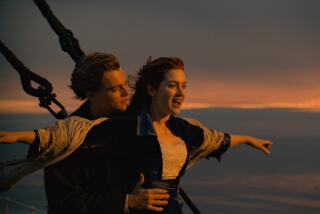‘The ocean is really an enchanting place.’
- Share via
Richard DeRosset has spent more than 15 years at sea, and nothing can sway the respect, admiration and understanding the 34-year-old La Mesa man has for the ocean. Not even being shipwrecked, as he once was, spending more than an hour in the ocean before the U.S. Coast Guard rescued him and his two crewmates. The depth of DeRosset’s passion for the sea can be seen in his paintings of all types of boats and ships as well as historical occurrences, such as the sinking of the Titanic. With no formal art training, he nevertheless has become one of the most sought-after marine artists in the nation, and is one of the official artists for the U.S. Coast Guard. DeRosset believes it is the “feel” an artist has for the subject that matters, not the amount of lessons that have been endured. To this end, he devotes as much time to researching a particular ship or event as he does to painting it, studying, for example, the vessel’s weight to understand how it would sit on the water, or the weather conditions at the time of some maritime event. His sense of humor sometimes comes through in his paintings in subtle ways, such as painting the people he dislikes onto the deck of the Titanic, depicted just before it sank. He was interviewed by Times staff writer Kathie Bozanich and photographed by Times staff photographer Bob Grieser.
The ocean is really an enchanting place. You may have hours of skull-numbing boredom, but there’s a certain enchantment about it even then. The ocean can be calm one moment and absolutely fierce the next. I have my best memories in this environment, and I’ve met my best friends in it, too.
When I was a kid, we had a large house with a lot of wooded area behind it and despite 10 acres of trees and old stone fences and stuff, I was fascinated with the lake and the rivers. And when I found an old boat on the lake, that was really great.
I was in the Navy for roughly five years, and the first job I had out of the Navy was on a fishing boat called the Petrol. I worked on that for about six months before it burned and sunk at night, 75 miles out to sea. There were 16-foot swells and really nasty weather. When we first stepped off the boat into the water, it was a very humbling experience.
Fortunately we had time to send out a “Mayday” on the radio, and we were rescued by the U.S. Coast Guard about an hour later. That’s why it gives me a great deal of pleasure to work for them, because in my own small way I am repaying them for saving my life.
I started painting in an odd sort of way. I had always liked to build model ships, since I was about 11. I went from plastic kits to these really intricate, scratch-built models that detail the original vessels. One day about eight years ago I went to a so-called nautical art show out at Shelter Island. If you like velvet paintings of Elvis Presley, then you would appreciate their interpretations of the sea and the ship.
Although I know absolutely nothing about art--I can’t tell you what kind of brushes I use or anything--I do know the ocean. As far as getting techniques down, I’ve talked to master painters, who have told me how to use the canvas, how to get the three-dimensional effects. Just by looking at a ship and looking at the beam and the way the hull is built, I can get a feel for the way it handles and how it should be depicted.
When I do a painting, I’m not going to do a painting depicting an old sailing ship with billowing white sails romantically sailing through the seas. I like to depict the ocean as it really is. Cold, wet, and sometimes very dangerous, but always intensely enchanting.
The research is the important thing. I have more than 1,000 ship plans in the basement, and have spent up to six months researching a particular event before painting it. For the Titanic painting, I found out that the sea was incredibly, almost eerily, calm. I also studied how the boat would be setting on the water and even the star constellations that would be in view from that particular angle.


